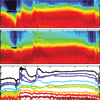
2015 THEMIS SCIENCE NUGGETS
SUMMARIES OF THEMIS RESEARCH
| <<View 2014 THEMIS Nuggets | Return to main page |
 Hiroshi Hasegawa, March 2015
Hiroshi Hasegawa, March 2015Magnetopause Reconnection Generates a Three-Dimensional Magnetic Flux Rope
We report the first in-situ observation of a plasma vortex induced by a solar wind dynamic pressure enhancement using THEMIS satellites inside our terrestrial magnetosphere - the region of Geospace shielded from the solar wind - and this finding is further confirmed by numerical simulation and ground-based observations. Read more.
 Andrew P. Dimmock, February 2015
Andrew P. Dimmock, February 2015A statistical study of the ion temperature dawn-dusk asymmetry in the terrestrial magnetosheath as a function of solar wind conditions
A statistical study of the dawn-dusk asymmetry for ion temperature in the dayside magnetosheath using THEMIS data. Our data shows a pronounced dawn favoured asymmetry which increases during faster solar wind speed. Read more.
 Hyomin Kim, February 2015
Hyomin Kim, February 2015Conjugate observations of traveling convection vortices associated with transient events at the magnetopause
A study of a transient event near the magnetopause observed by THEMIS revealed that the event is associated with a sudden solar wind dynamic pressure increase, causing an interhemispheric ground signature seen as traveling convection vortices (TCVs) in the conjugate hemisphere. Read more.
 Drew L. Turner, February 2015
Drew L. Turner, February 2015Energetic electron injections deep into the inner magnetosphere associated with substorm activity
Using a combination of 13 satellites including THEMIS, Van Allen Probes, and GOES, energetic electrons related to substorms were injected deeper into the magnetosphere than previously thought. These deeper injections are likely the result of interaction with a Pi2 frequency magnetosonic wave in the plasmasphere. Read more.
 Wen Li, January 2015
Wen Li, January 2015First Evidence for Chorus at a Large Geocentric Distance as a Source of Plasmaspheric Hiss: Coordinated THEMIS and Van Allen Probes Observation
Using coordinated observations between THEMIS and Van Allen Probes, we report on an interesting event, where chorus was observed at a large L-shell (~9.8), different from previously reported events at L < 6, but still exhibited a remarkable correlation with hiss observed in the outer plasmasphere (L ~ 5.5). Ray tracing simulation provides quantitative support that chorus from large L-shells, where it was previously considered unable to propagate into the plasmasphere, can in fact be the source of hiss. Read more.
 Qianli Ma, January 2015
Qianli Ma, January 2015Modeling inward diffusion and slow decay of energetic electrons in the Earth's outer radiation belt
We simulated the gradual diffusion processes of energetic electrons in the Earth's radiation belt, and found that the quiet-time electron dynamics are effectively controlled by inward radial diffusion and pitch angle scattering due to plasmaspheric hiss and EMIC waves. Read more.
 Please send comments/suggestions to
Emmanuel Masongsong / emasongsong @ igpp.ucla.edu
Please send comments/suggestions to
Emmanuel Masongsong / emasongsong @ igpp.ucla.edu